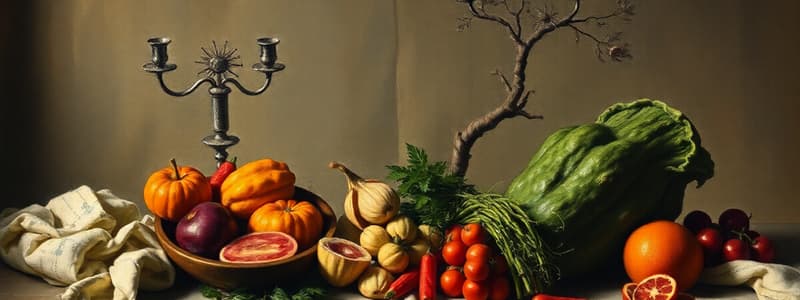Podcast
Questions and Answers
The domestication of plants and animals began around 10,000 AD.
The domestication of plants and animals began around 10,000 AD.
False (B)
The ancient Egyptians primarily used grains for religious practices.
The ancient Egyptians primarily used grains for religious practices.
True (A)
During the Middle Ages, food production was largely globalized and dominated by mass markets.
During the Middle Ages, food production was largely globalized and dominated by mass markets.
False (B)
The Columbian Exchange introduced new world foods like potatoes and tomatoes to Europe.
The Columbian Exchange introduced new world foods like potatoes and tomatoes to Europe.
The Industrial Revolution had no significant impact on food production methods.
The Industrial Revolution had no significant impact on food production methods.
Globalization in the 20th century led to the emergence of fusion cuisines.
Globalization in the 20th century led to the emergence of fusion cuisines.
Health and sustainability trends today focus on organic and local diets, along with food technology innovations.
Health and sustainability trends today focus on organic and local diets, along with food technology innovations.
Fast food chains emerged entirely in the 19th century, reshaping eating habits.
Fast food chains emerged entirely in the 19th century, reshaping eating habits.
The feudal system during the Middle Ages had an impact on food production.
The feudal system during the Middle Ages had an impact on food production.
Olive oil and wine were staples in the diets of ancient Greece and Rome.
Olive oil and wine were staples in the diets of ancient Greece and Rome.
Flashcards are hidden until you start studying
Study Notes
Food History
Prehistoric Era
- Hunter-Gatherer Societies: Early humans relied on foraging, hunting, and fishing.
- Domestication of Plants and Animals: Began around 10,000 BC; led to agriculture and settled communities.
Ancient Civilizations
- Mesopotamia: Cultivation of wheat and barley; emergence of beer and bread.
- Egypt: Use of grains; emphasis on food for religious practices and afterlife.
- Greece and Rome: Development of diverse diets; olive oil, wine, and bread were staples; meals often communal.
Middle Ages
- Feudal System: Food production was local; reliance on seasonal and preserved foods.
- Spices and Trade: Spices became valuable trade commodities; influenced cooking and preservation methods.
Renaissance to 18th Century
- Columbian Exchange: Introduction of new world foods (e.g., potatoes, tomatoes, corn) to Europe and vice versa.
- Culinary Arts: Emergence of formal cooking techniques and cookbooks; rise of the chef's status.
Industrial Revolution
- Food Production: Mechanization changed agriculture; processing methods improved shelf life.
- Urbanization: Increased demand for convenience foods; rise of food safety regulations.
20th Century
- Globalization: Increase in international trade; fusion cuisines emerged.
- Fast Food Industry: Growth of fast food chains reshaped eating habits and culture.
Contemporary Trends
- Health and Sustainability: Focus on organic, local, and plant-based diets; rise of food movements.
- Technology: Impact of food technology on production and distribution; innovations such as lab-grown meat.
Key Takeaways
- Food history reflects changes in agriculture, technology, and culture.
- Each civilization has contributed unique elements to modern diets.
- Historical events have significantly impacted food availability, preparation, and consumption.
Prehistoric Era
- Hunter-gatherer societies depended on foraging, hunting, and fishing for sustenance.
- Domestication of plants and animals began around 10,000 BC, marking the transition to agriculture and permanent settlements.
Ancient Civilizations
- Mesopotamia saw the cultivation of wheat and barley, leading to the creation of beer and bread.
- Ancient Egypt emphasized grain use and incorporated food into religious rituals and beliefs about the afterlife.
- In Greece and Rome, a diverse diet emerged, with staples including olive oil, wine, and bread; communal meals were common.
Middle Ages
- The feudal system localized food production, focusing on seasonal availability and preservation methods.
- Spices became highly sought after as trade commodities, significantly influencing cooking practices and food preservation.
Renaissance to 18th Century
- The Columbian Exchange introduced New World foods like potatoes, tomatoes, and corn to Europe and vice versa, altering diets on both continents.
- Culinary arts flourished with the emergence of formal cooking techniques and the publication of cookbooks, elevating the chef's role in society.
Industrial Revolution
- Mechanization transformed food production and agriculture, and new processing methods improved the shelf life of foods.
- Urbanization led to a growing demand for convenience foods and contributed to the establishment of food safety regulations.
20th Century
- Globalization fostered international trade, resulting in the emergence of fusion cuisines incorporated from various cultural backgrounds.
- The fast food industry expanded rapidly, changing eating habits and influencing cultural perceptions of food.
Contemporary Trends
- There is a rising focus on health and sustainability, promoting organic, local, and plant-based diets through various food movements.
- Advances in food technology impact production and distribution; innovations include lab-grown meat, reflecting changes in consumer preferences and concerns.
Key Takeaways
- The history of food illustrates profound shifts in agriculture, technology, and cultural practices over time.
- Unique contributions from various civilizations have shaped modern dietary habits.
- Significant historical events have transformed food availability, preparation methods, and consumption patterns.
Studying That Suits You
Use AI to generate personalized quizzes and flashcards to suit your learning preferences.




